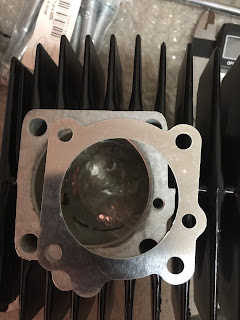The Honda Express NC50 engine that I have been running in my 1978 Honda Express since February, is a 1981 Honda Express NC50 single speed engine. I have the original engine, still in running condition, not sure what I want to do with it, but on the best days, it would hit 29 MPH. I have kept it as a running backup for some time now. The 1981 NC50 has a Treatland 47.6 Athena kit, Airsal head, MLM 20mm VM intake, 20mm VM Mikuni carb, MLM side bleed exhaust, Urban Express reed block with Carbon Fiber 0.3 mm reeds I found for a RC engine. I put the points ignition into the 1981 motor, so that the wiring harness didn't require modifications. The disadvantage is that it has fixed timing and you can feel the motor go flat on the top and my theory is that I could retard the timing at that point, driving some of the fuel burn into the pipe, heating the pipe up and bringing the motor back on the pipe. I do have an 1981 wiring harness with a 6 volt CDI that I will eventually swap in.
A couple things happened. I knew there was something happening in the motor, I saw the top speed drop to 48, then later I measured it at 45 and it was getting harder to start. Normally a single kick would start it, then it was taking 2, 3, 4, 5 kicks. I had been assuming I was losing the stator side crank seal. Three of the four motors I have torn apart have had bad stator side crank seals. The motor that I had built previous to this, shredded that seal and it would only rev to about 10K. The 1981 motor would push the little NC50 to 50 MPH at 13K and it spent a lot of time at 50 MPH. I figured I had lost the stator side crank seal. I also figured that single ring was probably pretty worn at this point.
The next motor I am working on, I am going to drill out an oil passage for that seal, much like the clutch side seal has. See the little hole in the cases on the right side of the crank balancer:
Then I was building another throttle cable for the VM20 and I thought I had good bonding of the cable, brass end and solder, but it pulled off and dropped into the motor riding to work at a stop sign. I pushed it back home and decided not to start it until I could pull the motor apart.
There were a couple discoveries, when I pulled the motor apart to retrieve the brass piece.
- Both crank seals were OK
- The cylinder skirt was cracked
- The reeds were fraying and delaminating
On the Treatland 47.6mm Athena kit, the place where the cylinder cracked does look like the weakest point on the cylinder. I'm not sure whether it broke because of an interaction with the cable end that dropped into the motor, or if this is a weak spot to keep an eye on.
So the cylinder is junk, so I put on a new 47.6mm Athena kit, that I had purchased for the two speed motor I am working on. Cylinder, Piston, Piston Pin, Circ Clips, Ring. I put two base gaskets on. I had some mild detonation on the combination I had on there. Another base gasket will lower the compression and little and raise all the ports. My guess is that I would like to get to about 90 ATDC for exhaust open, so raising the ports with another base gasket will help a little. The GPS will let me know whether this is the right thing to do or not.
I like to find the thinnest reed possible that will survive. This goes back to Mossbarger reed cages that I ran in the 80s and 90s on a Honda TRX250R quad. Terry Mossbarger was one of my mentors. His reed cages had very thin reeds and you could hear the difference in how an engine revved with thin Mossbarger reeds vs. thicker reeds like Boysen or V-Force. This disadvantage was that you always to to keep an eye on them since they were prone to fretting. I have compromised when I put this engine back together. I put in 0.4mm Carbon Tech reeds from Treatland, up from the 0.3mm reeds I was using. I will check these reeds periodically to see how they hold up.
The 1981 motor sounds and feels good again. I have just putted it around and blipped the throttle. I like to put at least three heat cycles on the engine, to seat the ring, before hammering on it. I only put one heat cycle on it this morning.




















































